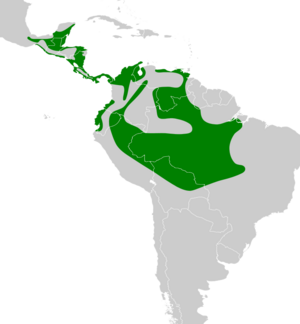White-necked puffbird facts for kids
Quick facts for kids White-necked puffbird |
|
|---|---|
 |
|
| Conservation status | |
| Scientific classification | |
| Genus: |
Notharchus
|
| Species: |
hyperrhynchus
|
 |
|
The white-necked puffbird (Notharchus hyperrhynchus) is a fascinating bird. It lives in many countries across Central and South America. This bird is part of the Bucconidae family, which includes puffbirds, nunlets, and nunbirds. They are known for their fluffy, "puffy" feathers.
Contents
About the White-necked Puffbird
Scientists study how different animals are related. For a while, the white-necked puffbird was thought to be the same as two other puffbird species. These were the buff-bellied puffbird and the Guianan puffbird. But now, scientists agree they are all separate species.
The white-necked puffbird has two main types, called subspecies. These are N. h. hyperrhynchus and N. h. paraensis. They are very similar but have small differences.
What Does It Look Like?
The white-necked puffbird is about 25 centimeters (10 inches) long. It weighs between 81 and 106 grams (about 3 to 3.7 ounces). Most of its body is a shiny black color.
It has a wide white area on its forehead, throat, and upper chest. Most of its belly is also white. A wide black band separates the chest from the belly. A black stripe goes from its beak to the top of its head. Its eyes are a dark red color.
The white color from its throat also goes around the back of its neck. The lower sides of its body have black and white stripes. Its tail is black with thin white tips on the feathers. This bird has a very large black beak and black feet. The two subspecies look almost the same. The only difference is that N. h. paraensis has an extra-long beak.
Where Does It Live?
The white-necked puffbird lives in many different places. You can find it from southern Mexico all the way through Central America. It also lives in northern Colombia and northwestern Venezuela. Other groups of these birds live in western Ecuador and southwestern Colombia.
Another large group is found in central Colombia, eastern Ecuador, and Peru. They also live in northern Bolivia and eastern Venezuela. From there, they spread into much of the Amazon rainforest in Brazil. The N. h. paraensis subspecies only lives in the Amazon River valley. This is in the Brazilian state of Pará.
These birds like many different kinds of places. They often live in areas that are partly open. This includes secondary forest (forest that has grown back) and the edges of primary forest (old, untouched forest). They also like open woodlands, savannas, and clearings. You can find them inside tropical evergreen forests too. They live at all levels of the forest, from the ground to the very top of the trees. They usually live from sea level up to about 1,200 meters (3,900 feet) high.
Behavior
Feeding Habits
The white-necked puffbird is a clever hunter. It waits on an open branch and then dives down to catch its food. It will even follow groups of army ants to find insects. After catching its prey, it hits it against the branch before eating.
This bird mainly eats insects. It also eats other small invertebrates (animals without backbones) and some fruits.
Reproduction and Life Cycle
The breeding season for white-necked puffbirds changes depending on where they live. But generally, they lay eggs between March and September. Both the male and female birds help dig out the nest. They usually make their nests in a termitarium (a termite mound) in a tree. They also use rotting trees.
Most nests are about 12 to 15 meters (39 to 49 feet) above the ground. Some nests have been found as low as 3 meters (10 feet) and as high as 18 meters (59 feet). They have also been seen nesting in holes in the ground or in an earth bank. From what we know, they usually lay two eggs at a time.
Vocalization
The white-necked puffbird has a unique song. People describe it as a long, bubbling trill. It can stay at the same sound level or go up slightly, then fall. Another description is a steady, unchanging trill that lasts 3 to 5 seconds. It also makes a "wheeew" sound that goes down in pitch. Sometimes, it makes a quiet growl.
Conservation Status
The IUCN (International Union for Conservation of Nature) has looked at the white-necked puffbird. They have listed it as a species of "Least Concern." This means it is not currently in danger of disappearing. It lives in a very large area. There are at least 500,000 adult birds. However, scientists believe the number of these birds might be slowly going down.


